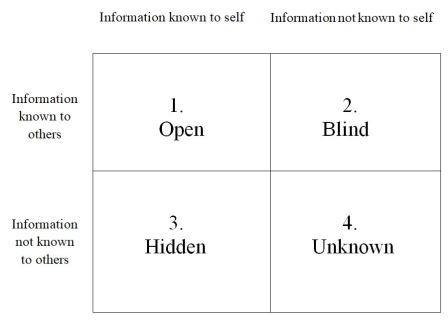1. Analysis of Self Awareness
It implies knowing about ourselves. To what extent, a person is aware of himself affects his interpersonal transactions. Johari Window is a useful framework to analyze self-awareness. Joseph Luft and Harrington Ingham have developed a diagram that gives to look at what one is conscious in one’s social exchanges and what one is not. Their Johari Window diagram is named by combining the first few letters of their names. Joseph Luft and Harrington Ingham have developed a model to look at one’s personality that can be known and unknown to self and known and unknown to others. The concept of Johari Window is shown in the following figure:

The above figure indicates that there are four parts (self) in all of us that has been indicated by four quadrants. These are explained below:
(a) Open Self
Open Self is known as Public area. This quadrant indicates information about self is known to oneself and also to others. The information relates to feelings, motivation and behaviour of an individual, which he is willing to share with those whom he comes in contact. It is clear to both what he is doing, how he is feeling and what his motives are. The individual behaves in a straight forward manner and is sharing. In an organizational setting, because of the openness of the individual the chances of conflict are reduced to minimum.
(b) Blind Self
This quadrant is related to information which is not known to self but known to others. Other people know what is happening to him but he is not aware of it. For example, an individual may not be aware of the fact that he is extremely task oriented and employees do not like it. In other words, others know and perceive the individual as a hard taskmaster and dislike him because of this. This is blind area that a person is blind to the fact that he interacts with others in the professional manner. This situation is likely to create an unpleasant atmosphere in the organization. Individual therefore should reduce blind area and increase public area. This will reduce conflict situations to a great extent in interpersonal behavior.
(c) Hidden Self
The hidden quadrant refers to states about the individual known to him but not known to others. This is private and only the person concerned knows what is happening. The hidden self is within the vision of the individual but he does not want to share with others. People learn to hide many feelings and ideas right from their childhood. The area is also called Private Area.
(d) Unknown Self
The unknown quadrant refers to states that neither the individual nor other people know about him. The unknown self is mysterious in nature. Sometimes feelings and motivation go so deep that no one including the person concerned knows about them. People experience unknown parts of life in dreams or deep rooted fears or compulsions. These acts, feelings and motives remain vague and unclear to people until they allow to surface.
Change in Awareness
The awareness about self keeps on changing continuously. As the awareness changes, the quadrant to which the psychological state is assigned also changes.
According to Jongeward, there are eleven principles of such change:
1. A change in any one quadrant will affect all other quadrants.
2. It takes energy to hide, deny, or be blind to behaviour which is involved in interaction.
3. Threat tends to decrease awareness whereas mutual trust tends to increase awareness.
4. Forced awareness is undesirable and usually ineffective.
5. Interpersonal learning means that a change has taken place so that one quadrant is larger and any one of the other quadrants has grown smaller.
6. Working with others is facilitated by a large enough area of free activity. It means more of the resources and skill of the persons involved can be applied to the task at hand.
7. The smaller the first quadrant, poorer will be the communication.
8. There is universal curiosity about the hidden area, but this is held in check by custom, social training and diverse fears.
9. Sensitivity means appreciating the covert aspects of behaviour in quadrants 2, 3 and 4 and respecting the desire of others to keep them so.
10. Learning about group processes, as they are being experienced helps to increase awareness (enlarging quadrant) for the group as a whole as well as for individual members.
11. The value system of a group and its members may be observed in the way the group deals with unknowns in the life of the group and of self.
